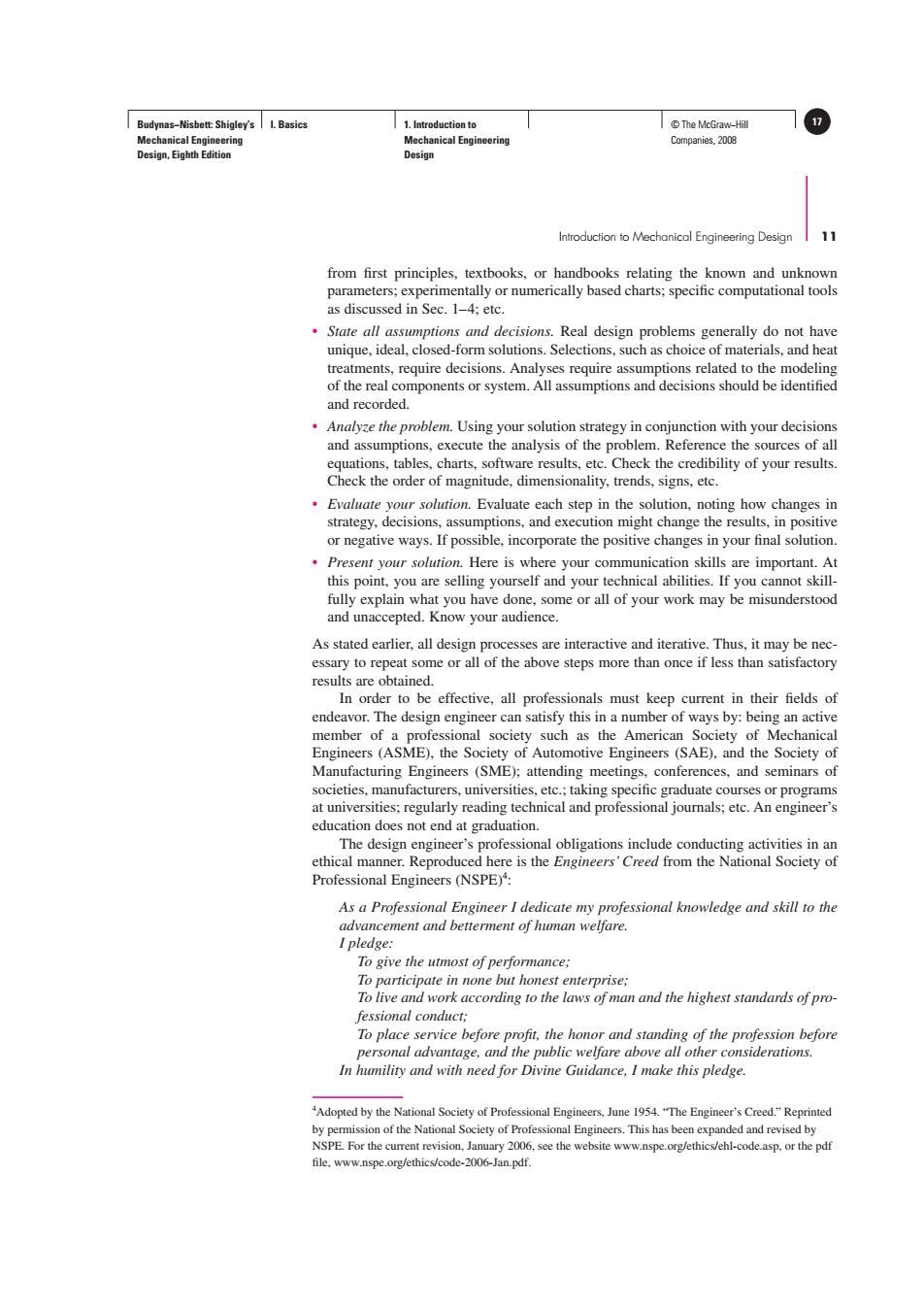正在加载图片...

Budynas-Nisbett:Shigley's I.Basics 1.Introduction to ©The McGraw-Hil Mechanical Engineering Mechanical Engineering Companies,2008 Design,Eighth Edition Design Introduction to Mechanical Engineering Design 11 from first principles,textbooks,or handbooks relating the known and unknown parameters;experimentally or numerically based charts;specific computational tools as discussed in Sec.1-4;etc. State all assumptions and decisions.Real design problems generally do not have unique,ideal,closed-form solutions.Selections,such as choice of materials,and heat treatments,require decisions.Analyses require assumptions related to the modeling of the real components or system.All assumptions and decisions should be identified and recorded. Analyze the problem.Using your solution strategy in conjunction with your decisions and assumptions,execute the analysis of the problem.Reference the sources of all equations,tables,charts,software results,etc.Check the credibility of your results. Check the order of magnitude,dimensionality,trends,signs,etc. Evaluate your solution.Evaluate each step in the solution,noting how changes in strategy,decisions,assumptions,and execution might change the results,in positive or negative ways.If possible,incorporate the positive changes in your final solution. Present your solution.Here is where your communication skills are important.At this point,you are selling yourself and your technical abilities.If you cannot skill- fully explain what you have done,some or all of your work may be misunderstood and unaccepted.Know your audience. As stated earlier,all design processes are interactive and iterative.Thus,it may be nec- essary to repeat some or all of the above steps more than once if less than satisfactory results are obtained. In order to be effective,all professionals must keep current in their fields of endeavor.The design engineer can satisfy this in a number of ways by:being an active member of a professional society such as the American Society of Mechanical Engineers (ASME),the Society of Automotive Engineers (SAE),and the Society of Manufacturing Engineers (SME);attending meetings,conferences,and seminars of societies,manufacturers,universities,etc.;taking specific graduate courses or programs at universities;regularly reading technical and professional journals;etc.An engineer's education does not end at graduation. The design engineer's professional obligations include conducting activities in an ethical manner.Reproduced here is the Engineers'Creed from the National Society of Professional Engineers(NSPE): As a Professional Engineer I dedicate my professional knowledge and skill to the advancement and betterment of human welfare. I pledge: To give the utmost of performance; To participate in none but honest enterprise; To live and work according to the laws of man and the highest standards of pro- fessional conduct; To place service before profit,the honor and standing of the profession before personal advantage,and the public welfare above all other considerations. In humility and with need for Divine Guidance,I make this pledge Adopted by the National Society of Professional Engineers,June 1954."The Engineer's Creed."Reprinted by permission of the National Society of Professional Engineers.This has been expanded and revised by NSPE.For the current revision,January 2006.see the website www.nspe.org/ethics/ehl-code.asp.or the pdf file,www.nspe.org/ethics/code-2006-Jan.pdf.Budynas−Nisbett: Shigley’s Mechanical Engineering Design, Eighth Edition I. Basics 1. Introduction to Mechanical Engineering Design © The McGraw−Hill 17 Companies, 2008 Introduction to Mechanical Engineering Design 11 from first principles, textbooks, or handbooks relating the known and unknown parameters; experimentally or numerically based charts; specific computational tools as discussed in Sec. 1–4; etc. • State all assumptions and decisions. Real design problems generally do not have unique, ideal, closed-form solutions. Selections, such as choice of materials, and heat treatments, require decisions. Analyses require assumptions related to the modeling of the real components or system. All assumptions and decisions should be identified and recorded. • Analyze the problem. Using your solution strategy in conjunction with your decisions and assumptions, execute the analysis of the problem. Reference the sources of all equations, tables, charts, software results, etc. Check the credibility of your results. Check the order of magnitude, dimensionality, trends, signs, etc. • Evaluate your solution. Evaluate each step in the solution, noting how changes in strategy, decisions, assumptions, and execution might change the results, in positive or negative ways. If possible, incorporate the positive changes in your final solution. • Present your solution. Here is where your communication skills are important. At this point, you are selling yourself and your technical abilities. If you cannot skillfully explain what you have done, some or all of your work may be misunderstood and unaccepted. Know your audience. As stated earlier, all design processes are interactive and iterative. Thus, it may be necessary to repeat some or all of the above steps more than once if less than satisfactory results are obtained. In order to be effective, all professionals must keep current in their fields of endeavor. The design engineer can satisfy this in a number of ways by: being an active member of a professional society such as the American Society of Mechanical Engineers (ASME), the Society of Automotive Engineers (SAE), and the Society of Manufacturing Engineers (SME); attending meetings, conferences, and seminars of societies, manufacturers, universities, etc.; taking specific graduate courses or programs at universities; regularly reading technical and professional journals; etc. An engineer’s education does not end at graduation. The design engineer’s professional obligations include conducting activities in an ethical manner. Reproduced here is the Engineers’ Creed from the National Society of Professional Engineers (NSPE)4 : As a Professional Engineer I dedicate my professional knowledge and skill to the advancement and betterment of human welfare. I pledge: To give the utmost of performance; To participate in none but honest enterprise; To live and work according to the laws of man and the highest standards of professional conduct; To place service before profit, the honor and standing of the profession before personal advantage, and the public welfare above all other considerations. In humility and with need for Divine Guidance, I make this pledge. 4 Adopted by the National Society of Professional Engineers, June 1954. “The Engineer’s Creed.” Reprinted by permission of the National Society of Professional Engineers. This has been expanded and revised by NSPE. For the current revision, January 2006, see the website www.nspe.org/ethics/ehl-code.asp, or the pdf file, www.nspe.org/ethics/code-2006-Jan.pdf